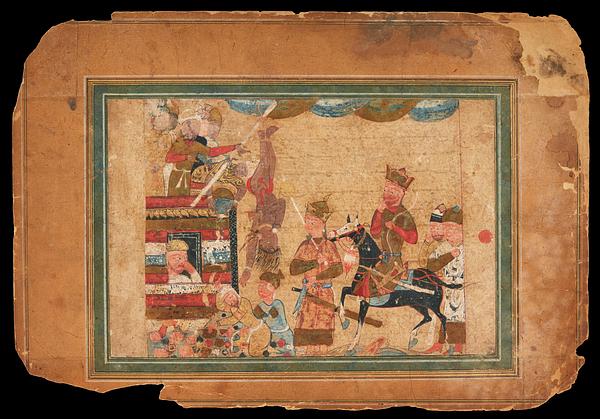The subject matter of this painting is enigmatic. On the right, a group including a mounted prince watches the scene unfolding to the left. Here, a dark-skinned, almost naked man hangs by his legs from a pole resting on the flat top of a building. On the roof of the structure, another person is emptying a round jar down its façade. In a window in the building below, a man pinches his nose – either because of the smell of what is being poured from the roof in front of him, or because of the smell rising from the scene unfolding on the ground below the window. Here, a kneeling man appears to be in the process of excavating corpse parts from a grave, using a small pickaxe for the task.
The painting was made in Sultanate India. The figures are square built with broad heads and small, narrow eyes. They wear turbans with an upright tip of fabric as well as caftans, which in some cases fall in the wavy, fold-like manner encountered in older Byzantine-influenced painting in the Levantine area (see, for example,
20/1988 and
19/2019). Depicting the sky as twisted bands of clouds is also a distinctive trait of this group of paintings, which includes
25/1980 as well.
[1] But while these paintings are generally very colourful and employ bold, uniform colours as a background,
A Prince Watching a Man Being Tortured is unusual in that it allows the untreated, uncoloured paper to form the background.
The painting has been cut from a manuscript, and none of the text is preserved. It may be an illustration for a scene from the marvellous story of Iskandar (Alexander the Great), either from an
Iskandarnama (the fifth poem in Nizami’s
Khamsa) or from an
Aina-i Sikandari (the fourth poem in Amir Khusraw Dihlawi’s
Khamsa).
